Related Research Articles
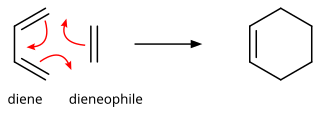
In organic chemistry, the Diels–Alder reaction is a chemical reaction between a conjugated diene and a substituted alkene, commonly termed the dienophile, to form a substituted cyclohexene derivative. It is the prototypical example of a pericyclic reaction with a concerted mechanism. More specifically, it is classified as a thermally-allowed [4+2] cycloaddition with Woodward–Hoffmann symbol [π4s + π2s]. It was first described by Otto Diels and Kurt Alder in 1928. For the discovery of this reaction, they were awarded the Nobel Prize in Chemistry in 1950. Through the simultaneous construction of two new carbon–carbon bonds, the Diels–Alder reaction provides a reliable way to form six-membered rings with good control over the regio- and stereochemical outcomes. Consequently, it has served as a powerful and widely applied tool for the introduction of chemical complexity in the synthesis of natural products and new materials. The underlying concept has also been applied to π-systems involving heteroatoms, such as carbonyls and imines, which furnish the corresponding heterocycles; this variant is known as the hetero-Diels–Alder reaction. The reaction has also been generalized to other ring sizes, although none of these generalizations have matched the formation of six-membered rings in terms of scope or versatility. Because of the negative values of ΔH° and ΔS° for a typical Diels–Alder reaction, the microscopic reverse of a Diels–Alder reaction becomes favorable at high temperatures, although this is of synthetic importance for only a limited range of Diels-Alder adducts, generally with some special structural features; this reverse reaction is known as the retro-Diels–Alder reaction.
The Wolff–Kishner reduction is a reaction used in organic chemistry to convert carbonyl functionalities into methylene groups. In the context of complex molecule synthesis, it is most frequently employed to remove a carbonyl group after it has served its synthetic purpose of activating an intermediate in a preceding step. As such, there is no obvious retron for this reaction. The reaction was reported by Nikolai Kischner in 1911 and Ludwig Wolff in 1912.
The 1,3-dipolar cycloaddition is a chemical reaction between a 1,3-dipole and a dipolarophile to form a five-membered ring. The earliest 1,3-dipolar cycloadditions were described in the late 19th century to the early 20th century, following the discovery of 1,3-dipoles. Mechanistic investigation and synthetic application were established in the 1960s, primarily through the work of Rolf Huisgen. Hence, the reaction is sometimes referred to as the Huisgen cycloaddition. 1,3-dipolar cycloaddition is an important route to the regio- and stereoselective synthesis of five-membered heterocycles and their ring-opened acyclic derivatives. The dipolarophile is typically an alkene or alkyne, but can be other pi systems. When the dipolarophile is an alkyne, aromatic rings are generally produced.
The Wittig reaction or Wittig olefination is a chemical reaction of an aldehyde or ketone with a triphenyl phosphonium ylide called a Wittig reagent. Wittig reactions are most commonly used to convert aldehydes and ketones to alkenes. Most often, the Wittig reaction is used to introduce a methylene group using methylenetriphenylphosphorane (Ph3P=CH2). Using this reagent, even a sterically hindered ketone such as camphor can be converted to its methylene derivative.

Dichlorine monoxide is an inorganic compound with the molecular formula Cl2O. It was first synthesised in 1834 by Antoine Jérôme Balard, who along with Gay-Lussac also determined its composition. In older literature it is often referred to as chlorine monoxide, which can be a source of confusion as that name now refers to the ClO• radical.
In organic chemistry, hydroboration refers to the addition of a hydrogen-boron bond to certain double and triple bonds involving carbon. This chemical reaction is useful in the organic synthesis of organic compounds.
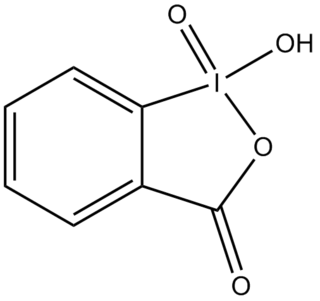
2-Iodoxybenzoic acid (IBX) is an organic compound used in organic synthesis as an oxidizing agent. This periodinane is especially suited to oxidize alcohols to aldehydes. IBX is prepared from 2-iodobenzoic acid, potassium bromate, and sulfuric acid. Frigerio and co-workers have also demonstrated, in 1999 that potassium bromate may be replaced by commercially available Oxone. One of the main drawbacks of IBX is its limited solubility; IBX is insoluble in many common organic solvents. In the past, it was believed that IBX was shock sensitive, but it was later proposed that samples of IBX were shock sensitive due to the residual potassium bromate left from its preparation. Commercial IBX is stabilized by carboxylic acids such as benzoic acid and isophthalic acid.
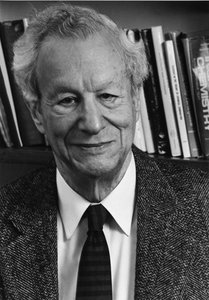
Frank Henry Westheimer was an American chemist. He taught at the University of Chicago from 1936 to 1954, and at Harvard University from 1953 to 1983, becoming the Morris Loeb Professor of Chemistry in 1960, and Professor Emeritus in 1983. The Westheimer medal was established in his honor in 2002.

Spartan is a molecular modelling and computational chemistry application from Wavefunction. It contains code for molecular mechanics, semi-empirical methods, ab initio models, density functional models, post-Hartree–Fock models, and thermochemical recipes including G3(MP2) and T1. Quantum chemistry calculations in Spartan are powered by Q-Chem.
A harpoon reaction is a type of chemical reaction, first proposed by Michael Polanyi in 1920, whose mechanism involves two neutral reactants undergoing an electron transfer over a relatively long distance to form ions that then attract each other closer together. For example, a metal atom and a halogen might react to form a cation and anion, respectively, leading to a combined metal halide.
Physical organic chemistry, a term coined by Louis Hammett in 1940, refers to a discipline of organic chemistry that focuses on the relationship between chemical structures and reactivity, in particular, applying experimental tools of physical chemistry to the study of organic molecules. Specific focal points of study include the rates of organic reactions, the relative chemical stabilities of the starting materials, reactive intermediates, transition states, and products of chemical reactions, and non-covalent aspects of solvation and molecular interactions that influence chemical reactivity. Such studies provide theoretical and practical frameworks to understand how changes in structure in solution or solid-state contexts impact reaction mechanism and rate for each organic reaction of interest.
Robert George Bergman is an American chemist. He is Professor of the Graduate School and Gerald E. K. Branch Distinguished Professor Emeritus at the University of California, Berkeley.
The Taft equation is a linear free energy relationship (LFER) used in physical organic chemistry in the study of reaction mechanisms and in the development of quantitative structure–activity relationships for organic compounds. It was developed by Robert W. Taft in 1952 as a modification to the Hammett equation. While the Hammett equation accounts for how field, inductive, and resonance effects influence reaction rates, the Taft equation also describes the steric effects of a substituent. The Taft equation is written as:

Takai olefination in organic chemistry describes the organic reaction of an aldehyde with a diorganochromium compound to form an alkene. It is a name reaction, referencing Kazuhiko Takai, who first reported it in 1986. In the original reaction, the organochromium species is generated from iodoform or bromoform and an excess of chromium(II) chloride and the product is a vinyl halide. One main advantage of this reaction is the E-configuration of the double bond that is formed. According to the original report, existing alternatives such as the Wittig reaction only gave mixtures.
In Lewis acid catalysis of organic reactions, a metal-based Lewis acid acts as an electron pair acceptor to increase the reactivity of a substrate. Common Lewis acid catalysts are based on main group metals such as aluminum, boron, silicon, and tin, as well as many early and late d-block metals. The metal atom forms an adduct with a lone-pair bearing electronegative atom in the substrate, such as oxygen, nitrogen, sulfur, and halogens. The complexation has partial charge-transfer character and makes the lone-pair donor effectively more electronegative, activating the substrate toward nucleophilic attack, heterolytic bond cleavage, or cycloaddition with 1,3-dienes and 1,3-dipoles.
Sharon Hammes-Schiffer is a physical chemist who has contributed to theoretical and computational chemistry. She is currently a Sterling Professor of Chemistry at Yale University. She has served as senior editor and deputy editor of the Journal of Physical Chemistry and advisory editor for Theoretical Chemistry Accounts. As of 1 January 2015 she is editor-in-chief of Chemical Reviews.

Dr. Dan Thomas Major is a Professor of Chemistry at Bar Ilan University specializing in Computational Chemistry.
Mario Barbatti is a Brazilian physicist, computational theoretical chemist, and writer. He is specialized in the development and application of mixed quantum-classical dynamics for the study of molecular excited states. He is also the leading developer of the Newton-X software package for dynamics simulations. Mario Barbatti held an A*Midex Chair of Excellence at the Aix Marseille University between 2015 and 2019, where he is a professor since 2015.
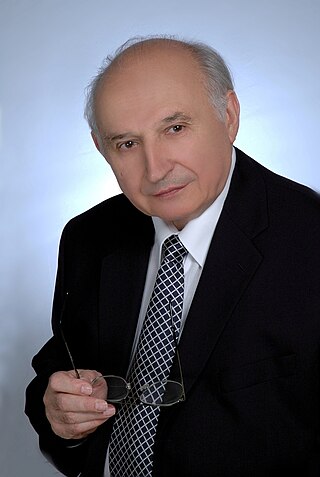
Imre Gyula Csizmadia was a Canadian Hungarian chemist, university professor, external member of the Hungarian Academy of Sciences.
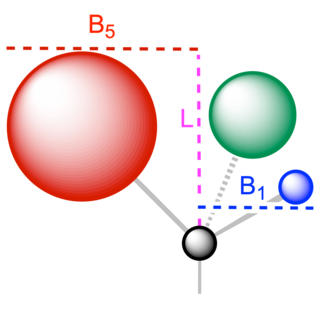
A sterimol parameter is a set of vectors which describes the steric occupancy of a molecule. First developed by Verloop in the 1970s. Sterimol parameters found extensive application in quantitative structure-activity relationship (QSAR) studies for drug discovery. Introduction of Sterimol parameters into organic synthesis was pioneered by the Sigman research group in the 2010s. Benefiting from the multi-dimensional values that they carry, sterimol parameters give more accurate predictions for the enantioselectivity of asymmetric catalytic reactions than its counterparts, especially in cases when structurally complicated ligands are used.
References
- ↑ "Obituaries in Tallahassee, FL | Tallahassee Democrat". tallahassee.com. Retrieved 2023-10-02.
- ↑ "Cooke Tree #1" (PDF). CareerChem. Retrieved 29 June 2022.
- ↑ "DeLos Fletcher DeTar". Tallahassee.com. Tallahassee Democrat. Retrieved 29 June 2022.
- ↑ DeTar, D.F.; Silverstein, R. (1966). "Reactions of Carbodiimides. I. The Mechanisms of the Reactions of Acetic Acid with Dicyclohexylcarbodiimide". Journal of the American Chemical Society. 88 (5): 1013–1019. doi:10.1021/ja00957a027 . Retrieved 29 June 2022.
- ↑ DeTar, D.F.; Luthra, N.P. (1980). "Quantitative evaluation of steric effects in SN2 ring closure reactions". Journal of the American Chemical Society. 102 (13): 4505–4512. doi:10.1021/ja00533a033 . Retrieved 29 June 2022.
- ↑ DeTar, D.F.; Luthra, N.P. (1977). "Conformations of proline". Journal of the American Chemical Society. 99 (4): 1232–1244. doi:10.1021/ja00446a040. PMID 833398 . Retrieved 29 June 2022.
- ↑ DeTar, D.F.; Tenpas, C.J. (1976). "Calculations of steric hindrance in ester hydrolysis based on estimation of van der Waals strain energies of alkanes". Journal of the American Chemical Society. 98 (15): 4567–4571. doi:10.1021/ja00431a039 . Retrieved 29 June 2022.
- ↑ DeTar, D.F. (1976). "Editorial". Computers and Chemistry. 1 (1): 1. doi:10.1016/0097-8485(76)80001-0 . Retrieved 29 June 2022.
- ↑ "Emerita/Emeritus Status | Office of Faculty Development and Advancement". fda.fsu.edu. Retrieved 2023-12-21.
- ↑ DeTar, DeLos F. (2007). "Calculation of Entropy and Heat Capacity of Organic Compounds in the Gas Phase. Evaluation of a Consistent Method without Adjustable Parameters. Applications to Hydrocarbons". Journal of Physical Chemistry A. 111 (20): 4464–4477. Bibcode:2007JPCA..111.4464D. doi:10.1021/jp066312r. PMID 17447733 . Retrieved 1 July 2022.
- ↑ "Historic Fellows". AAAS. Retrieved 29 June 2022.
- ↑ "Florida Award". Florida Local Section. American Chemical Society. Retrieved 29 June 2022.
- ↑ "Carleton DeTar". University of Utah. Retrieved 1 July 2022.
- ↑ DeTar, DeLos F.; DeTar, Carleton E. (1966). "General Computer Techniques for Evaluating the Time-Concentration Relationships Predicted by Reaction Mechanisms, Including Complex Enzyme Mechanisms". Journal of Physical Chemistry. 70 (12): 3842–3847. doi:10.1021/j100884a016 . Retrieved 1 July 2022.